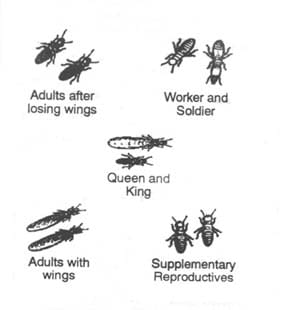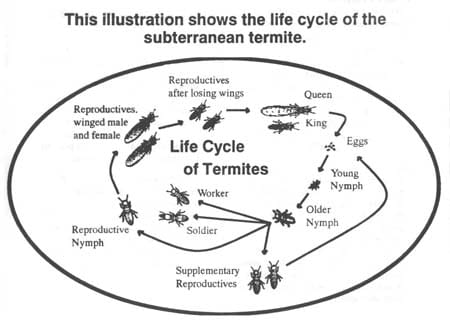Source(s):
- Elizabeth S. Vantine, Master Gardener
- Gary R Peiffer
It is important to correctly identify an insect as a termite. This way, you may be able to dismiss an insect that is not a termite. On the other hand, if you confirm the presence of termites, it is time to begin educating yourself on what to do next.
IS IT AN ANT? OR IS IT A TERMITE?
OTHER INSECTS THAT CAN DAMAGE WOOD IN BUILDINGS
- Carpenter ants
- Carpenter bees
- Powder-post beetles
COST OF DAMAGE FROM SUBTERRANEAN TERMITES
Subterranean termites cause millions of dollars worth of damage each year to buildings across the United States. Much of this loss occurs here in the South. It is important to check buildings often for evidence of termite infestation.
DETECTING TERMITE INFESTATION
Visible Evidence
 Obvious external evidence of subterranean termite damage includes:
Obvious external evidence of subterranean termite damage includes:
- Flights of adults emerging from soil or wood.
- Discarded wings on floors beneath doors and windows where termites have emerged within a building and tried to escape.
- Flattened, earthen shelter tubes running from the soil upward along the foundation walls into the building itself.
Hidden Damage:
Most subterranean termite damage is not visible on the surface, but it can completely honeycomb wooden timbers, leaving only a thin shell covering the surface. These are called “galleries.” Find these galleries by removing weatherboarding or trim boards or by probing suspicious areas with an ice pick or a knife. Termites do not push out sawdust-like material from their galleries.
PROTECTING EXISTING BUILDINGS FROM TERMITE DAMAGE
Look for areas termites favor where warm, moist soil contains an abundant wood supply or other cellulose material. Keep crawl spaces clean. Do not allow scrapes of wood to accumulate. Provide plenty of ventilation under buildings. Check cracks and voids in foundations and concrete floors through which termites may establish tunnels between the soil and wood.
AVOIDING FUTURE PROBLEMS WITH NEW CONSTRUCTION METHODS
Planning New Construction
Good building practices help insure long-term protection against subterranean termites. Termites must maintain contact with soil or other sources of moisture or they will die. Your Extension Service can provide you with detailed building methods and information designed to prevent problems from the beginning.
Selecting Resistant Materials
Pressure-impregnated wood chemically-treated by a standard process provides maximum protection where wood must be in contact with the soil. Certain species of native wood resist termites, but are not as resistant as pressure-treated wood.
AREAS OF POTENTIAL INFESTATION
Subterranean termites frequently infest certain types of construction including:
- Concrete slabs on the ground.
- Crawl spaces with inadequate clearance, ventilation, and drainage.
- Foundations under enclosed porches and terraces where filled earth comes very close to the building timber.
- Buildings with no basement and slab-on the ground construction attract termites along the inside of the foundation, while
- Buildings with basements more often attract termites outside the foundation.
IF YOU SUSPECT YOU HAVE A TERMITE PROBLEM…
Termite control requires specialized equipment and knowledge. Retain the services of a competent, licensed professional termite control service. For a list of the name of termite eradication professionals, contact the
- Better Business Bureau,
- Georgia Department of Agriculture Pesticide Division,
- County Extension Service,
- Georgia Pest Control Association,
- Experienced friends.
Get at least three estimates. Don’t automatically go with the lowest estimate. Select the professional you have the most confidence in and feel the most comfortable working with.
FIND AN EXPERT TO ERADICATE TERMITES.
IF YOU SUSPECT YOU HAVE A TERMITE PROBLEM…
Remove
All loose and unnecessary wood from underneath and adjacent to buildings with crawl spaces, including form boards and other debris. All wood units that connect the soil with the exterior woodwork of the building, such as trellises. All soil within 18 inches of floor joists and 12 inches of girders.
Replace
Needed units, such as trellises, in a way to avoid creating new contacts between soil and woodwork. Wooden piers and posts with pressure-applied preserved wood. Damaged and structurally weakened sills, joists, flooring, etc. with sound material.
Fill
Voids, cracks or expansion joints in concrete or masonry with either cement grout, roofing-grade coal-tar pitch or rubberoid bituminous sealers.
Provide
Adequate drainage and ventilation around and under the building.
Inspect
Frequently for evidence of new infestation. Wooden buildings in areas of high infestation should be inspected annually.
FREQUENT INSPECTION IS SIMPLY GOOD INSURANCE.
Identifying Subterranean Termites:
The subterranean termite has:
- Two short thread-like or bead-like straight antennae,
- Two pairs of wings similar in size, shape, and pattern with many veins,
- Four stubs remaining after the wings detach, and
- A long rectangular body.
Life Cycle of the Subterranean Termite
Examining a piece of infested wood most likely reveals the wingless, grayish-white worker termites. The other mature forms are soldiers and reproducing adults. All individuals of each form pass through three stages: egg, nymph, and adult.
Center Publication Number: 26
- Carrying and Transporting Chainsaws - October 18, 2016
- How To Prepare Samples For Handling - September 24, 2013
- Identification and Prevention of Termite Problems - September 24, 2013